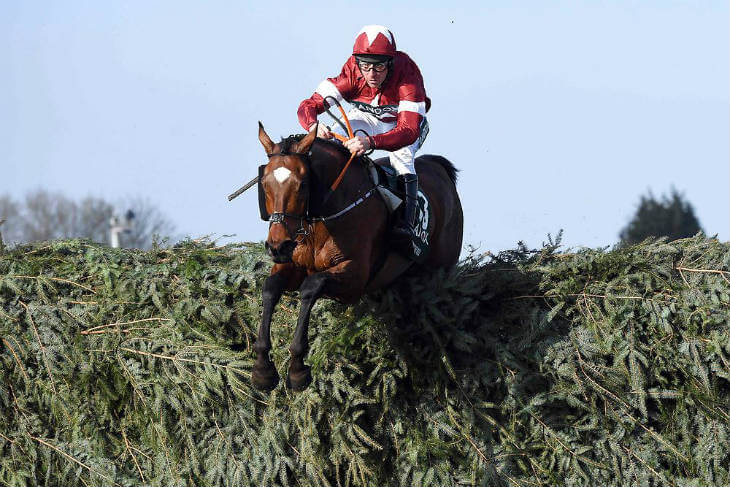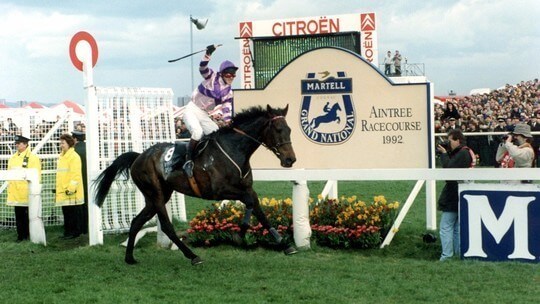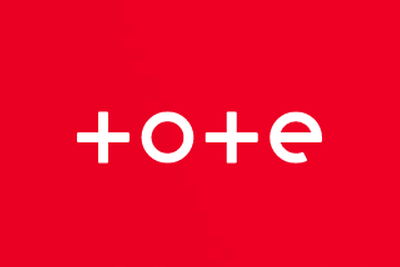Grand National A-Z
Last Updated 5 Apr 2024 | By The GrandNational.org.uk StaffHere you’ll find an alphabetical take on the most famous horse race throughout the ages. Become a trivia expert with all the Grand National fun facts you need to know, plus even more for good measure!
Once you’re armed with all the facts, apply them to your 2024 Grand National bets! See our betting offers to make the most of Grand National 2024.
Grand National Fun Facts
A
A is for Aldaniti, who, like his jockey Bob Champion, made a comeback against all the odds to win the Grand National in 1981. This feat that was immortalised by the film “Champions”.
A is also for Aintree, Liverpool L10, which staged its first Flat race in 1829, and the Liverpool Grand Steeplechase in February 1836.
Amateurs – plenty of amateur jockeys have upstaged their professional rivals in the National, with the last member of the unpaid ranks to taste victory being journalist Marcus Armytage, who won on Mr Frisk in 1990. Eight years earlier, amateur Dick Saunders became the oldest winning jockey in the race, when partnering Grittar to victory, aged 48. Mr Bretherton was the first successful amateur – aboard Jerry in 1840.
B
B is for Captain Martin William Becher, who, features a great deal in Grand National Fun Facts. Riding 20-1 shot Conrad in the first Grand National in 1839, he took a soaking when his mount fell in a specially constructed water jump – the sixth and 22nd fence – which became known as Becher’s Brook. “I never knew water tasted so foul without whisky in it”, he remarked.
B is also for Rachael Blackmore, the trailblazing Irish jockey who became the first female to win the Grand National, when she rode Minella Times to victory in 2021.
C
C is for The Chair, at 5ft 2in, with a 6 foot wide ditch on the take-off side, it is Aintree’s most daunting obstacle. The famous fence is actually only jumped once and is named after its position, which is opposite the ‘seat’ reserved for the ‘distance’ judge. It is located at the site of the accident that claimed the only human life in the National’s history: in 1862, Joe Wynne fell here and died from his injuries. This brought about the ditch on the take-off side of the fence in an effort to slow the horses on approach. The ground on the landing side is six inches higher than on the takeoff side, creating the opposite effect of the drop at Becher’s. The fence was originally known as the Monument Jump but The Chair came into more regular use in the 1930s.
D
D is for Devon Loch, the Queen Mother’s horse who was assured of victory in the 1956 National when, with a 10-length lead, he inexplicably did the splits 50 yards from the line, almost depositing dumbstruck Dick Francis on the turf. This is a favourite of the Grand National Fun Facts. To ‘do a Devon Loch’ therefore means to pluck defeat from the jaws of victory.
D is also for Distance: the winning margin equivalent to more than 30 lengths, which was last achieved in the 2001 Grand National when Red Marauder led four finishers home. Only the winner and Smarty put in a clear round, as Blowing Wind and Papillon were remounted. Other horses to win the race by a distance are Cloister (1893), Covertcoat (1913), Shaun Splash (1921), Tipperary Tim (1928) and Mr What (1958).
E
E is for Elbow, the kink in the 494-yard run-in, where Grand National fun facts have been reported. In 1973, an eight-year-old called Red Rum overhauled the brave top weight Crisp and Richard Pitman to clinch the honours and, 18 years later,
Seagram did the same to Pitman’s son Mark, aboard Gold Cup winner Garrison Savannah.
E is also for Early Mist – the first of Vincent O’Brien’s three straight Grand National winners between 1953 and 1955, with Royal Tan and Quare Times taking the following two renewals, making the legendary handler the only person to saddle three winners in a row.
F
F is for Foinavon, the 100-1 outsider (444-1 on the Tote) for the 1967 race, who skipped clear of his rivals who were caught in a pile-up at the 23rd fence, the 4ft 6in obstacle that now bears his name. The riderless Popham Down had caused chaos, bringing almost the whole field to a standstill, except Foinavon, who was so far back his jockey had time to go round the melee and jump the fence miles clear. According to Grand National Fun Facts, Foinavon was so unfancied his owner and trainer didn’t turn up to watch!
F is also for Fences – there are 16 on the National course, of which 14 are jumped twice, making 30 in all, and for Five Fifteen, the new starting time for the great race from 2016, a change designed to allow even more people to view the spectacle around the world.

Jockey Davy Russell jumps the last fence on Tiger Roll on his way to winning the Grand National horse race on the final day of the Grand National Festival at Aintree Racecourse in Liverpool, northern England on April 14, 2018. / AFP PHOTO / PAUL ELLIS @SCANPIX
Each Grand National fence is made from a wooden frame and covered with distinctive spruce branches sourced from forests in the Lake District
G
G is for Golden Miller, the 1934 winner and the only horse in history to land the Grand National and Cheltenham Gold Cup in the same season.
G is also for Gambles – the plunge from 33-1 to 10-1 on Papillon in 2000 cost the bookies £10million
And for Greys – only three have ever won the race: The Lamb won twice in 1868 and 1871, while Nicolaus Silver and Neptune Collognes are the only greys in the last two centuries to win, (in 1961 and 2013 respectively).
H
H is for Bruce Hobbs, the youngest Grand National winning jockey – he was just 17 when he drove Battleship to a narrow success in 1938.
Handicap – with the horses allotted different weights, from 11st 10lb down to 10st, meaning that all 40 runners should theoretically cross the finishing line together. Senior BHB handicapper Phil Smith has had plenty of criticism from trainers in the past. A few of them may have wished that he’d carried out his threat of throwing himself off the Aintree grandstand
if the 2003 Grand National winner scored by more than seven lengths. One of the more morbid Grand National Fun Facts; Monty’s Pass romped home by 12.
I
I is for Ireland, which has supplied six of the last seventeen National heroes (although Silver Birch was their last winner in 2007).
Also for Ilex – in 1890, renowned gambler George Masterman reckoned his horse was “a certainty” under 10st 5lb. He was right – Ilex was sent off the 4-1 favourite and won easily. I is also for ITV who won the right to screen the big race on terrestrial TV from 2017.
J
J is for jockeys, the almost certifiable men on top. George Stevens is the most successful jockey in National history, winning five times (1856, 1863, 1864, 1869 and 1870) – twice more than anyone else. Ruby Walsh and Leighton Aspell have been the jockeys to follow in the Grand National Fun Facts in recent years, with two wins each. Since 2012, any jockey – amateur or professional – riding in the Grand National must have ridden at least 10 winners over fences and a minimum of 15 in total in hurdles and chases.
J is also for Jim Joel, whose Maori Venture scored in 1987. He is the oldest winning owner, at 92.
K
K is for Count Graf Karl Kinsky, the Austro-Hungarian nobleman. He became the first rider from outside the British Isles to compete in the Grand National. Kinsky won on his debut when his mare Zoedone beat just nine rivals. It was the smallest-ever field assembled for the race – to score in 1883.
L
L is for Lottery, the winner of the first Grand National in 1839, who was aptly named, given the part played by chance in every running.
L is also for Last Suspect, who sprang a 50-1 shock in 1985 and who is remembered for trainer and arch pessimist Captain Tim Forster’s final words to jockey Hywel Davies: “Keep remounting.”
M
M is for Donald ‘Ginger’ McCain. The Southport-born car salesman and part-time taxi driver trained Red Rum to win three Grand Nationals (1973, 1974 and 1977). He then saddled 2004 winner Amberleigh House.
M is for the Melling Road, which the runners cross on the way to the first fence.
M is also for Manifesto: the epitome of a Grand National horse who ran in the race eight times between 1897 and 1904. He won twice, finished third three times, came fourth once and eighth on his final start, aged 16! He only once failed to complete.
N
N is for Nickel Coin, who in 1951 became the 13th and most recent mare to land the Grand National and for None: the number of Grand National winners ridden by champion jockeys Peter Scudamore and John Francome. Scudamore managed one third on Corbiere in 1985, while Francome finished second in 1980 and third in 1979 on Rough And Tumble.
Arguably the greatest pilot of all, Tony McCoy, broke his Grand National duck aboard Don’t Push It in 2010. Whilst Paul Nicholls trained his first winner in 2012, courtesy of Neptune Collognes.
N is also for Nose, being Neptune Collongnes’ winning margin in 2012. According to Grand National Fun Facts, this was the shortest winning margin in the history of the race.
O
O is for Sir Peter O’Sullevan, the ‘Voice of Racing’. He delivered his first commentary on the race on the radio in 1947, switching to television 13 years later. O’Sullevan’s final Grand National call was for Lord Gyllene’s win in 1997. It was 49 hours later than expected, owing to an IRA bomb scare.
O is also for Owners: Holidaycamp magnate Fred Pontin celebrated success in the 1971 Grand National with Specify. This win inspired Trevor Hemmings to get into racehorse ownership. He, in turn, tasted victory at Aintree with Hedgehunter in 2005, Ballabriggs in 2011 and Many Clouds in 2016. 1976 winner, Rag Trade, was owned by Raymond Bessone. Bessone was better known as Mr Teasy-Weasy. He is widely regarded as Britain’s first celebrity hairdresser and had his own show at Saturday teatime.
P
P is for Jenny Pitman – dubbed the ‘Queen of Aintree’ as the first woman to have trained a National winner. She was successful with Corbiere in 1983 and Royal Athlete 12 years later. Her son Mark trained Smarty, who finished second to Red Marauder in 2001.
P is also for Party Politics, who scored for coincidence backers in 1992 – his win came five days before the General Election.
Party Politics, ridden by Carl Llewellyn, winning the 1992 Grand National
Q
Q is for the Queen Mother, who philosophically observed: “Well that’s racing,” as her Devon Loch capsized 50 yards from the line in the 1956 National.
Q is also for Quare Times, who gave Vincent O’Brien an unprecedented Grand National hat-trick in 1955. Three years later O’Brien switched from jumping to concentrate on the Flat and won the Derby just the six times!
R
R is for Red Rum, the world’s most famous racehorse and a favourite topic of Grand National Fun Facts. He dead-heated for an Aintree selling plate the day before Foinavon’s success in 1967. ‘Rummy’, exercised on Southport beach by Ginger McCain, and returned to land the 1973 and 1974 Grand Nationals. Second, in each of the two following years, he became the only three-time victor in 1977. He is now buried by the winning post.
R is also for Geraldine Rees, who became the first woman to complete the National on Cheers in 1982. Fred Rimell deserves a mention, training four horses to win the National between 1956-76. This including a grey, Nicolaus Silver.
Finally, R is for Reserves – since 2000, every year bar one (2004) has seen a full field of 40 line up. This is partly due to a system of reserves begun in 2000. Runners are declared 48 hours before the race and up to four reserves can be utilised the previous day if one of the original declarations is a non-runner by 9am.
S
S is for Dick Saunders, whose victory as a 48-year-old amateur on Grittar in 1982 makes him the oldest Grand National winner.
S is also for Tommy Stack who was on board for Red Rum’s historic third win. In 1991 hero Seagram is another for the coincidence fans – Seagram sponsored the race.
Finally, S is for Spectators: crowds of around 70,000 racegoers flock to Aintree on Grand National day. The estimated worldwide audience is 600 million, with the race being distributed to around 140 countries.
T
T is for Nigel Twiston-Davies. He stunned the BBC’s Des Lynam after Earth Summit’s 1998 victory with a brusque: “I don’t do interviews.” He was more forthcoming after Bindaree’s win in 2002.
T is also for Tiger Roll, who became the first horse to win the Grand National in successive years since Red Rum, when he passed the winning post first in both 2018 and 2019.
T is for the heroic John Thorne, a 54-year-old amateur who chased home Aldaniti on Spartan Missile in 1981. The final Grand National Fun Facts for T is Topham: the family involved in the creation of the great race. Mr Edward William Topham was part of the original syndicate which first staged races at Aintree. He took over the lease of the course in 1848, which remained within the family until 1973. The track is now part of Jockey Club Racecourses.
U
U is for the USA. With a staple diet of boring six-furlong claiming races, is it any wonder Americans are fascinated by the Grand National? Both Jay Trump (1965) and Ben Nevis (1980) started life over fences in the USA before winning the Grand National. US owners have won on ten occasions, including in 1938 with Battleship, who was owned by Randolph Scott’s wife Marion Du Pont Scott. The most recent US-owned winner was Betty Moran’s Papillon in 2000.
V
V is for Valentine’s. In 1840, Irish amateur rider Alan Power had a bet he would reach the stone wall fence first on Valentine. He did, and his horse gave his name to the lesser of Aintree’s two brook fences.
V is also for a Void race. The infamous 1993 running of the Grand National was declared void after a chaotic start. Some horses got tangled in the starting tape, so a false start was announced. Though, 30 of the 39 starters failed to heed the false start notice. Jenny Pitman’s Esha Ness completed the course in first, the race was declared void.
W
W is for weights. The biggest weight carried in the race is 13st 4lb by 1839 winner Lottery when he returned in 1841. He was pulled up at Becher’s second time. Horses carrying more than 11st have had a better record in recent years, with Hedgehunter in 2005, Don’t Push It in 2010, Neptune Collognes in 2012 and Many Clouds in 2016. They all carrying more than 11st to victory. The most carried to victory is 12st 7lb, by four horses, Cloister (1893), Manifesto (1899), Jerry M (1912) and Poethlyn (1919). The most incredible of Grand National Fun Facts was Manifesto who in 1890, carried 12st 13lb to finish third.
X
X is for X-ray, which brings us to the eccentric aristocrat Beltran de Osorio y Diez de Rivera. The “Iron” Duke of Albuquerque was a true Grand National nutter. Between 1952 and 1976 he had seven rides in the race, the last aged 57. He completed once (he finished eighth on Nereo in 1974), fell three times and pulled up twice. He sustained, by his own reckoning, 107 fractures at Aintree. This included a broken leg, cracked vertebrae and broken ribs. The not so Grand National Fun Facts state he was declared medically unfit to ride in 1977.
Y
Y is for Arthur Yates, whose Grand National Fun Facts career is one of extreme fortunes. Playman, Yates’s first runner, was running loose when he fell and killed jockey James Wynne in 1862. Yates returned to win with Roquefort in 1885 and Cloister, who carried 12st 7lb to win by 40 lengths, in 1893. The Youngest jockey to win the Grand National was Bruce Hobbs. He was 17 when he triumphed on board Battleship in 1938.
Z
Z is for Zoedone, the mare who holds the record as the slowest Grand National winner. She recorded a time of 11m 39s. Owned and ridden by Bohemian diplomat Count Charles Kimsky, the mare won the 1883 renewal of the Grand National.
Z is also for Zongalero, Nicky Henderson’s first runner in the race when second to Rubstic in 1979. This is still the Seven Barrows trainer’s best placing.
You might also like…
[wp-review id=”75″]








